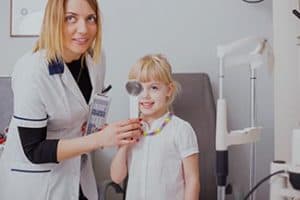What are eye drops used for?
Your eye doctor may have used eye drops during the eye exam of your child or may have prescribed eye drops for use. Eye drops are commonly administered or prescribed by eye doctors for a number of different reasons.
The most common reasons are:
- Dilating the eye’s pupil
- Relaxing the focusing lens
- Treating dry eyes or eye allergies
- Treating lazy eye
- Managing myopia progression
Dilation of the pupil
A pediatric comprehensive eye exam includes a thorough examination of your child’s vision and ocular health. During the examination, your eye doctor may insert drops into the lower lid of your child’s eye to enlarge their pupils— this is called mydriasis. Pupil dilation enables a clear view of the inner eye and all of its structures, such the lens, vitreous and retina, which is necessary for detection of ocular disease.
Do dilating drops hurt?
No, but they may sting a little.
Your eye doctor will gently place one or two eye drops into your child’s lower eyelid. Following insertion, your child may feel mild stinging or burning. Don’t be alarmed— this sensation only lasts a few seconds!
Will my child’s vision be affected by the eye drops?
The eye drops will cause blurry near vision and light sensitivity for as long as the pupil remains dilated.
Many eye doctors recommend bringing sunglasses to your appointment to ease any discomfort after the exam.
Additionally, if your child wears contact lenses, bring a pair of glasses to your appointment, since the eye drops contain preservatives that can be absorbed by contact lenses and cause irritation. It is rare to have an allergic reaction to the dilating eye drops, but it is important to be aware of the symptoms of an allergic reaction, such as dry mouth, flush face, rapid pulse and fever.
After your child’s eye exam, regular daily tasks at school are permitted, though they may not feel up to it, as blurred near vision and sensitivity to light can be uncomfortable. If your child does not feel like going to school, your doctor can write an explanatory note for the teacher.
How long do the effects last for?
The dilating drops take approximately 10 – 20 minutes to work, and the effects gradually wear off over the next few hours.
Depending on the concentration of the eye drops, as well as the individual child, the effects can last up to 3-6 hours, so it’s best to schedule the eye exam for the end of the day. Children with lighter eyes tend to feel the effects of the drops longer than those with darker eyes.
Contact an eye doctor near you to discuss eye drop options for your child.
SEE RELATED: Eye Exams for Children
Eye drops for relaxing the lens
During an eye exam, a child’s focusing lens may work harder than usual to provide clear vision. To obtain an accurate measure of a refractive error, the lens must be relaxed. Eye drops for cycloplegia, or relaxing the lens, will be placed in your child’s eyes for this reason.
Cycloplegia is necessary for obtaining an accurate measure of a refractive error. With the use of special lenses, the eye doctor can achieve a precise calculation of the correct optical prescription that is most appropriate for your child.
These drops will also dilate the pupil and cause near vision to be blurry for a few hours, so sunglasses are also recommended for use afterwards.
Eye drops for dry eye and allergies
Dry eye syndrome (DES)
Up to 7% of all children suffer from a form of dry eyes.
Dry eye syndrome in children is typically caused by poor tear quality, the most frequent cause being Meibomian Gland Dysfunction (MGD), which lowers the oil content of the tears. Other causes of dry eye syndrome include blepharitis, an eyelid infection, and reactions to medications such as antihistamines, which are used to control allergies.
In addition, dry eye can be caused by contact lenses, pink eye (eye infections), or nutritional deficiency caused by a low intake of omega-3 fatty acids.
Smart phones and dry eye
According to the American Optometric Association (AOA), prolonged smartphone use has been linked to dry eye syndrome in children. Prolonged use of a digital device results in reduced blinking—causing a faster evaporation of lubricating tears. When this occurs, dry eye symptoms result.
97% of children with dry eyes, had more than three hours of smartphone use daily
The good news is, when these children significantly reduced their smartphone use, their dry eye symptoms improved.
Dry eyes can range from a mild inconvenience, to a chronic problem. Many children will feel relief from their symptoms with regular use of artificial tears lubricating eye drops, and some lifestyle changes.
Eye allergies
Many children suffer from eye allergies—usually as a result of airborne allergens such as pollen, dust, mold, and pet dander.
Common symptoms of allergies are watery, red, itchy eyes, and swollen eyelids. While these symptoms can be both bothersome and frustrating for children and parents, the good news is, eye drops have been proven to provide relief. Anti-allergy eye drops typically contain antihistamines that will reduce an allergic reaction in the eyes.
For mild eye allergy symptoms, non-prescription artificial tear eye drops may be sufficient in providing relief. These drops are available over the counter at a local drug store, and can be used as often as needed. There are many different brands available, so ask your eye doctor for a recommendation.
For more severe allergy symptoms, a stronger prescription medication will be recommended.
Preservative free eye drops
Both dry eye syndrome and eye allergies can usually be treated with artificial tears eye drops. Preservative-free drops are recommended because they contain fewer additives which can irritate the eyes. Keep in mind that many of these preservative-free eye drops may only be used for a few weeks after the bottle is opened— it is important to follow the directions on the bottle.
In addition, many eye drops come in two forms, single use preservative free vials or multi-use bottles, with or without preservatives. There are advantages and disadvantages to both. Ask your eye doctor what he recommends for your child’s individual needs.
Atropine drops for lazy eye and myopia management
Lazy eye treatment
Atropine eye drops are typically used in combination with a vision therapy program for the treatment of lazy eye.
These drops are applied to the non-affected eye (the ‘good’ eye) in order to blur the vision of this eye and force the lazy eye to work and therefore become stronger— thereby strengthening the eye-brain connections for the lazy eye.
Atropine drops can cause physical discomfort such as stinging and blurry vision— which may result in your child refusing insertion of the eye drops. The good news is that recent research conducted by the PEDIG team has shown that using the drops only a few times per week, such as on the weekend, is still effective in treating lazy eyes. This finding will hopefully help to encourage your child to use their atropine drops.
Myopia management
Atropine eye drops have been shown to reduce myopia progression.
A very low dose of this medicated eye drop is placed in the lower eyelid every day. This method is ideal for children between the ages of 8 and 15. Side effects may include blurry near vision or light sensitivity.
There are many reasons that your eye doctor has for using eye drops for your child —dilation of the pupil, relaxing the eye’s focusing, lubrication of the cornea, and treatment of certain vision problems.
A comprehensive eye exam is crucial in detecting any ocular health or vision conditions. Discuss any problems your child may be experiencing with your eye doctor, to enable early detection and treatment.
LEARN MORE: Guide to Children’s Eye Exams
Schedule an appointment with an eye doctor for a comprehensive eye exam, and to discuss any questions you may have about treating your child’s eye condition.









